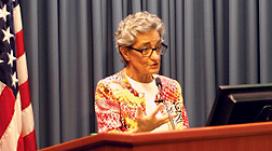Trucks in Towns: Urban Freight Congestion
When urban traffic problems come to mind, who thinks first about trucks? Genevieve Giuliano does. A professor and senior associate dean at the University of Southern California (USC), Giuliano's credentials also include her roles as Ferraro chair in Effective Local Government and director of the National Center for Metropolitan Transportation Research (METRANS) Transportation Center at USC's Sol Price School of Public Policy.
This month, U.S. Transportation Secretary Ray LaHood announced that Dr. Giuliano had been selected as a member of the National Freight Advisory Committee. She recently visited Volpe, The National Transportation Systems Center to speak at a recent Straight from the Source event.
Giuliano said transportation experts are starting to revisit the problems of freight movement in cities. It is a growing challenge, as the world becomes more urbanized, and growing urban populations demand more deliveries to their own doors. This shifts truck traffic away from centralized destinations, such as stores, to every home and business. Suddenly more trucks are competing with passenger vehicles for road capacity and parking spots. "It's rife with inefficiencies," she said. "Both the 'first mile' and the 'last mile' have multiple vendors visiting a single origin and a single destination."
Giuliano also noted that all this concentrated trucking is incompatible with smart growth principles. "Smart growth says to reduce road capacity, create vehicle-free zones, and prioritize mixed use development—which puts cars and trucks in conflict." Because fuel efficiency and emissions controls in trucks lag behind those for cars, increased trucking means increased emissions and energy consumption, not to mention additional noise, safety concerns, and general 'livability' concerns in partially residential areas.
A less obvious challenge is that local jurisdictions have very little control over urban freight traffic. "Freight has no borders," said Dr. Giuliano. "We produce for export, outsiders produce for us. Commerce is regulated interstate, but supply chains are very fluid," and it is difficult to develop good policies to manage them. Unsurprisingly, the challenges of urban freight movement are magnified in transportation hubs.
Reviewing the Research
Giuliano and her colleagues have been reviewing all available literature on this challenge and have compiled tables of strategies and their applications. "The real world is way ahead of the research," said Giuliano, explaining that current attempts to manage freight traffic are totally ad hoc. "Everyone is experimenting with solutions, but there is almost no systematic research to understand what everyone is doing—and whether it works."
"There are many possibilities for better managing urban freight," Giuliano said. The U.S. faces a number of mostly institutional challenges. "We like to give locals the authority to manage land use, but not other institutional issues," she said. "So local interest groups have learned to use the environmental review process [the National Environmental Protection Act] as their veto power, even if the proposal is part of a sensible policy."
Dr. Giuliano outlined the next steps for research.
- Document the problem, with data on truck flows and pickup/delivery characteristics.
- Develop analytical tools to compare alternatives and predict the outcomes of alternative strategies.
- Systematically analyze the impacts of programs on traffic and on industry, documenting costs and outcomes and comparing similar programs implemented in different contexts.
To learn more, view the video highlights from Genevieve Giuliano's talk.

